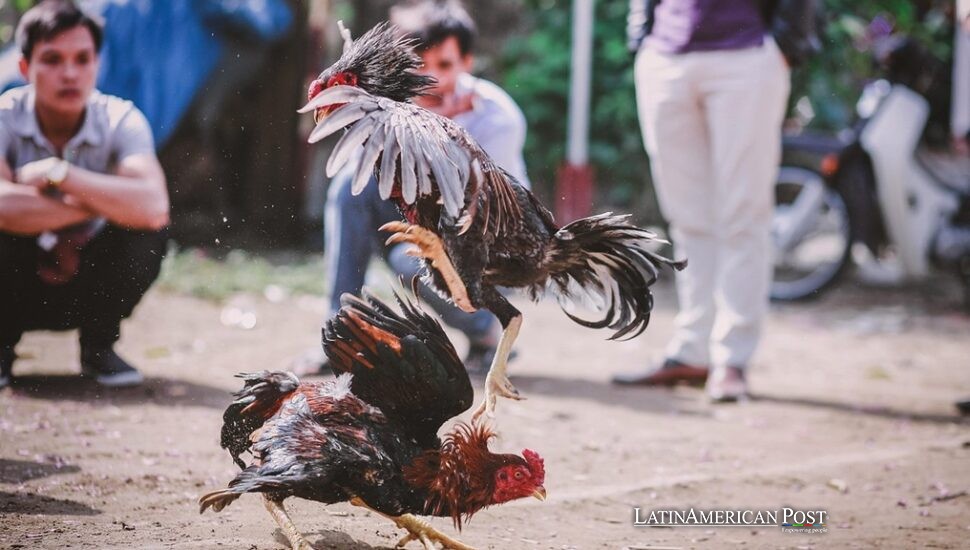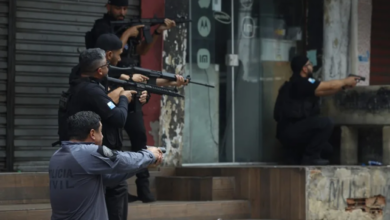Blood, Feathers, and Pride: Latin America’s Cockfighting Culture

Last week’s shocking crime in rural Ecuador, where twelve people were brutally murdered amid an illicit cockfighting event, underscores a centuries-old tradition that still runs deep across Latin America, blending cultural heritage, fervent betting, and grim reality in many communities.
From Tragedy in Ecuador to a Rich History
The entire region was shocked to learn that heavily armed men wearing military-style disguises stormed a cockfighting venue in La Valencia, El Carmen, Ecuador, just before midnight. The attackers fired many bullets at spectators who were watching the event, which created fear and destruction around the area. By the time the gunfire ceased, twelve people had lost their lives, and many more were severely injured. In the days that followed, Ecuadorian special operations police units moved swiftly, raiding multiple sites and arresting four individuals—three men and one woman—who were allegedly tied to this brutal assault. The evidence discovered during the investigation comprised firearms along with computer equipment, cash, and military-style uniforms.
The sheer brutality of this terrible incident made headlines internationally because it brought renewed attention to cockfighting, which continues to take place in some Latin American regions. For many, a cockfight is a thrilling contest in which dedicated breeders pit roosters against each other in a display of feathers, spurs, and primal aggression. Yet the same venues can, at times, be enmeshed in illicit networks, plagued by illegal betting, gang activity, and money laundering.
Cockfighting continues to be a deeply rooted cultural practice in several Latin American nations due to its long-standing historical traditions. Since ancient times, through Spanish conquests and into modern days, cockfights have taken place in dusty arenas. The practice of cockfighting transformed into social events where fans from various social backgrounds participated, with farm laborers making small wagers and wealthy individuals placing large bets. All gatherings serve dual purposes as sports events and social displays while they receive support from a historical defense of community “heritage” and identity.
To truly understand how one tragic night in Ecuador could shake a nation—and how cockfighting continues to captivate entire regions—one must look at the centuries-old legacy of this blood sport. Its survival emerges from a combination of cultural reverence, historical continuity, and the powerful thrill it offers to spectators. However, as the recent massacre demonstrates, the darker side of the industry can prove deadly, forcing governments and activists alike to question how best to balance local tradition with public safety and animal welfare.
Tracing the roots of cockfighting leads us through a circuitous path of legendary stories, ancient warfare metaphors, and colonial expansions. Some historians believe that roosters were first domesticated for fighting long before humans ever raised chickens for food. We hear about ancient Greek generals using the birds’ courage to inspire their armies or Roman elites who believed that a rooster’s brave spirit reflected the virtues of the gods of war. When the Spanish colonized vast stretches of the Americas, they brought these cultural practices with them, embedding cockfighting in New World societies.
Today, in Mexico and parts of Central and South America, cockfights range from regulated events with municipal or state oversight to secretive encounters in remote areas. The difference between the two can be stark: legal palenques (cockfight arenas) charge entrance fees, follow government gambling regulations, and post disclaimers about local laws, while underground rings might be ephemeral, shifting from one abandoned warehouse to another.
Ecuador experienced a terrible attack. The nation struggles with increasing violence from organized crime. Such incidents show underlying weaknesses. Where people gamble a lot and turn into attractive targets for gangs. Illegal exchanges of firearms and narcotics happen there. This strengthens a criminal reality distinct from a romanticized view of rooster combat.
The Atmosphere of the Cockfighting Ring
To enter a cockfighting ring in certain parts of Latin America is to step into a world awash in adrenaline, tension, and spectacle. Typically, you approach through a small entrance gate that opens into a circular pit surrounded by tiered seating. The ring itself is lined with a sandy or earthen floor—kept damp to prevent excessive dust from rising when the roosters kick up a flurry of feathers.
Spectators flock to secure the best views, often arriving early to examine the participating birds and size up the opponents. Groups of friends will banter excitedly, drink in hand, and analyze the roosters’ weight, wingspan, and posture as though discussing two heavyweight boxing champions. The air fills with raucous music, anything from traditional rancheras to pounding reggaetón. Sellers walk around the paths. They offer treats like tobacco along with regional drinks, such as pulque or aguardiente.
Before a match starts, stress grows. The birds come from woven containers or cages. Each rooster’s feathers reflect bright lights above. Handlers carefully strap on spurs or gaffs—sometimes sleek, curved blades, other times short, rigid spike extensions—turning the rooster’s natural leg spur into a lethal weapon. Onlookers lean forward, shouting last-minute bets. The noise can be deafening: a mix of frenzied commentary, shrill whistles, and cheers from fans rooting passionately for their chosen bird.
When the birds are finally placed beak to beak in the center of the ring, the crowd hushes for a split second. Then comes a powerful roar of collective excitement as the fight explodes into motion. Roosters leap at each other, wings flapping furiously, sharp metal attachments slashing at every attack. Dust flies. Feathers scatter. The ring judge circles the birds, ensuring that neither side gains an unfair advantage and that rules, loose as they might be, are followed.
Time in the pit feels elastic. A fight can end quickly if one bird lands a lucky strike to a vital artery, or it can last up to fifteen minutes if the combatants match each other blow for blow. Either way, the outcome is usually fatal for at least one bird; in many cases, both roosters succumb to blood loss. As soon as the fight ends, bets are collected or paid out, and the next matchup is prepared.
The arena contains both harsh violence and a form of fellowship. People living nearby greet one another as acquaintances, talk about rooster ancestry, remember previous contests, or discuss current raising methods. To them, cockfighting is more than a harsh activity – it connects their societies. People of any age meet to tell tales, form bonds through local practices passed down through generations, or praise a popular activity.
Nevertheless, as the tragedy in Ecuador has shown, this cultural microcosm can quickly invert into a nightmare. When criminal elements seep in, the sense of collective pride and excitement can turn deadly. Firearms replace friendly banter, and fear ripples through every corner of the arena.
Breeding, Training, and the Rules of Engagement
One reason cockfighting maintains its hold on the popular imagination is the sheer dedication of breeders. Known in Spanish as galleros or traberos_, these individuals might spend years refining bloodlines to create the perfect “gamecock”—a rooster noted for its resilience, aggression, and strength. Legend has it that entire family legacies can be traced through roosters, with certain lineages prized for their strategic fighting style or razor-sharp instincts.
From birth a chick can receive specific training. The training consists of adjusted food intake, physical activity schedules along with frequent handling. Some raisers give extra nutrients or shots to improve the animal’s resistance. They work to enlarge all possible gains. Roosters that will fight stay separated from other fowls. This prevents early wounds or a decline in their combat readiness.
As the bird matures, serious preparation begins. Handlers might “spar” roosters against less formidable opponents to sharpen their reflexes. The bird’s weight is carefully recorded, and its mental toughness is observed. A gamecock that shrinks from confrontation or shows timidity might be removed from the breeding program. Only those roosters who display unwavering aggression stand a chance in the ring, where hesitation often spells swift defeat.
Of course, these meticulously bred and trained birds enter fights governed by specific guidelines, which vary by region. In Mexico, for instance, official palenques require roosters to weigh in beforehand. Officials enforce a time limit, typically around ten to fifteen minutes, though some variants allow extended matches until a bird can no longer fight. Bladed spurs are commonly used, but the shape and length can differ among local traditions. Some communities even have specialized medical staff on-site to treat roosters in the event of minor injuries.
Gambling is a basic part of cockfighting. Several wagers occur at the same time. The central bet is the sum decided on by the rooster owners. Other bets go around the ring among the people present. Such side bets change from small amounts to big money plus mirror social connections. In many areas the action of gambling is as important as fighting. It builds excitement, making rivalries more intense along with making the result meaningful.
Across Latin America, laws differ. For instance, Peru and areas of Mexico see cockfighting as a cultural custom under state control. Others have attempted to ban it outright, often facing stiff resistance from local communities that see it as part of their historical identity. Even where it is legal, the lines between regulated and underground cockfights often blur, partly because unauthorized rings are more profitable for organizers who want to avoid taxes and official scrutiny.
Cultural Reverence, Controversy, and the Road Ahead
The tradition of cockfighting in Mexico originated during the colonial period and remains integrated into yearly celebrations and family events. Many supporters view the fight as more than a violent contest since it embodies a tapestry of values such as bravery and honor symbolized by the steadfast rooster. People passed down the cockfighting spectacle as a shared cultural identity plus a historical legacy. The cultural importance of this practice goes past simple fun or betting games.
Opposition is also powerful. Organizations that care for animal welfare from various locations disapprove of cockfighting as savage. It produces inescapable pain for the fowl, and harsh training methods are needed. These methods make the birds extremely aggressive. Medical evidence suggests that birds do experience pain, and the short yet vicious nature of their battles yields horrific injuries. Furthermore, cockfighting events often serve as flashpoints for illegal gambling, gang presence, money laundering, and violent crime. In the United States, the tie between cockfighting rings plus drug-dealing groups has been documented.
Ecuador’s event shows how far criminal actors can enter such events. After the attack, police found guns and items like law enforcement or military outfits. This suggested that well-organized groups wanted to look like paramilitary forces. Ecuador saw more violence linked to drug cartels besides gang fighting. The events described offer criminals chances for exploitation.
The national and international conversation, therefore, hinges on a complicated question: can cockfighting persist in some sanitized, regulated form without feeding criminal undercurrents or sacrificing animal welfare standards? Some proponents argue that when properly supervised—much like horse racing or professional boxing—cockfights could be safer and more transparent, channeling revenue into local economies and cultural institutions. Opponents counter that cruelty to animals is intrinsic, and no amount of regulation can erase the bloodshed at the heart of the sport.
As for Ecuador, the country has been grappling with a broader wave of violence, prompting President Daniel Noboa to declare an “internal armed conflict” aimed at confronting organized criminal groups. The massacre in El Carmen is only the most recent chilling example of how quickly “terrorist” bands can strike. Cockfighting continues in many rural areas. Increased public attention could cause increased policing or bans soon.
Elsewhere in Latin America, the cultural standing of cockfighting shows few signs of disappearing. In Mexico, efforts to have “ballistics” recognized as an intangible cultural heritage reflect an ongoing belief that the practice is part of the nation’s soul. In states like Aguascalientes, roosters remain a fixture in fairs and festivals. Critics maintain that tradition cannot justify cruelty, and they challenge governments to enact stricter bans. The conflict between cultural values plus moral worries keeps influencing what happens to cockfighting in the area.
Two possibilities are available. With one choice, cockfighting moves toward oversight. Definite regulations plus sterile methods fashion a secure space. This lessens participation by dangerous offenders, even with the activity’s violent character. An outright ban on cockfighting would satisfy animal rights groups but might lead to illegal activities conducted in secret and increase underworld influence.
Also Read: Bridging Oceans: Conflict in Lebanon, Hope in Latin America
For now, the echoes of gunfire in that fateful Ecuadorian cockfight ring resonate far beyond the country’s borders. They call attention to the extremes, both the cultural zeal and the illicit dangers—of an ancient practice that refuses to fade quietly. From the vantage point of tradition, cockfighting embodies defiance, historical memory, and local pride. Yet, from the standpoint of modern law and moral scrutiny, it increasingly appears like an anachronism overshadowed by blood, suffering, and all too frequently, deadly violence.





